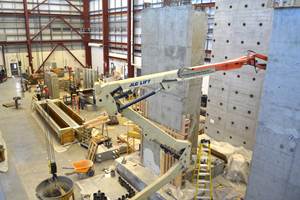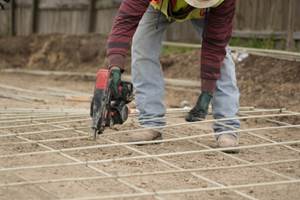Low-cost carbon fiber: Real or just wishful thinking?
In a wide variety of applications, from easy-to-install bridges to ultra-lightweight, fuel-efficient vehicles, there has been great excitement in recent years about the potential for using carbon fiber-reinforced composites.
In a wide variety of applications, from easy-to-install bridges to ultra-lightweight, fuel-efficient vehicles, there has been great excitement in recent years about the potential for using carbon fiber-reinforced composites. Still, there are many unknowns and technical hurdles to overcome before carbon can be broadly accepted for commercial use: We need more robust and rapid processing technologies, reliable repair technologies and user-friendly joining techniques. In addition, we must fully understand the fiber's high-speed impact behavior to predict its crash-worthiness and its long-term durability, not to mention our need to optimize its compatibility with resin systems other than epoxies. It is generally believed, however, that with time and effort these technical obstacles will be overcome. But only if the real "800-lb gorilla" is removed — carbon fiber's cost compared to other candidate materials. For transportation, infrastructure and consumer-goods applications, the "silver bullet" is a low-cost carbon fiber that can be produced in commodity-scale quantities. If current research is successful, low-cost carbon fiber may become a sustainable commodity.
Current global production capacity for commercial-grade carbon fiber is on the order of 50 million lb per year. Today, North American vehicle production averages >18 million units per year. Just 10 lb of carbon fiber in each North American vehicle would create a demand almost four times greater than current world production capacity. If carbon fiber were used in half the potential applications, with only 40 wt/% of the composite being carbon fiber, then each vehicle would require 134 lb/61 kg of carbon fiber. A 50x increase in capacity would be required just to meet North American production requirements in the automotive industry alone — it would not meet the needs of the many other industries that would grow as a result of automotive industry penetration and experience. To achieve such drastic industry scale-up, changes will be required to carbon fiber production technologies, production facilities, packaging, emission control procedures and, likely, even changes in the precursors used to manufacture carbon fiber.
The greatest contributors to high cost in carbon fiber production are the precursors and the capital equipment necessary for conversion of the precursor (see the cost-comparison chart on facing page), according to a cost study commissioned by Oak Ridge National Laboratory (ORNL, Oak Ridge, Tenn.). Carbon fiber is typically made by highly controlled thermal pyrolysis of only a few types of precursors. This naturally begs the question: Are these the only materials, energy methods, and production technologies capable of producing carbon fiber? Precursor alternatives and non-thermal processing methods are under investigation, and much of that research is being conducted at ORNL, funded by the Department of Energy's FreedomCAR initiative.
ORNL currently has four such projects in its portfolio. The first is to develop low cost precursors based on kraft lignin, which is a by-product of the papermaking process. Kraft lignin is the major type of lignin produced and the portion that is not used in the papermaking process is often burned for process heat and power. The project has focused on precursor formulations that can be melt-spun, a method that eliminates the expense of dissolution of the principal precursor into a solvent. While a number of widely available materials have been tried successfully, precursor formulations consisting of 80 to 95 percent lignin and 5 to 20 percent polyethylene terephthalate (PET) have proven to be readily melt-spinnable. Work with this formulation has shown that stabilization and graphitization can be carried out at reasonable temperatures and within reasonable time frames. Composition analysis shows highly graphitic and uniform structures with moduli approaching that of commercially available polyacrylonitrile (PAN)-based carbon fibers. Process yields have approached 50 percent. Current activities are directed at spinning multiple fiber bundles.
The second project, conducted by Hexcel Corp. (Sandy, Utah) and overseen by ORNL, aims to develop ways of using commodity-grade PAN as a precursor. Commodity PAN sells for roughly one-half the cost of current carbon fiber-grade PAN, which includes primarily those grades typically used in sporting goods and other consumer products. The use of commodity PAN could result in a $1.50/lb reduction in fiber price. Commodity textile acrylic fiber costs about $0.70/lb to $0.90/lb. In the course of down-selecting the technologies, Hexcel (1) processed and evaluated various state-of-the-art and developmental PAN precursors; (2) developed the continuous, inline chemical modification and demonstrated a reduction of stabilization times by ~40 percent; (3) evaluated and selected E-beam radiation technology for pre-stabilization; (4) developed a continuous, two-stage sulfonation process for non-PAN fibers; (5) developed cost models for the selected technologies.
Hexcel's project is focusing on technologies that could be commercialized using available industrial facilities and infrastructures with the smallest possible capital investments. The project's goal is to define the low-cost carbon fiber technologies, the materials and facilities those technologies would require, support those conclusions with detailed manufacturing cost analysis, and develop models for processing costs.
The third project aims to reduce the cost of converting precursors into carbon fibers. Pitch, PAN or rayon precursors are typically processed by highly controlled thermal pyrolysis of the precursors under mechanical stress, leaving only the carbon in a preferred structure and orientation of that structure. Applying a new approach, ORNL has been using microwave energy-generated plasmas to carbonize and graphitize precursors. An initial continuous pilot unit, designed to demonstrate technical feasibility, achieved a line speed of six inches per minute. At the time of this summary, however, a production line speed of >200 inches per minute had been reached using the fourth-generation unit with 50K tow precursors. Currently, ORNL is refining the process parameters for running full multiple spools of continuous 50K tow precursors and optimizing to obtain desired properties. To date, this research has reportedly reduced overall fiber cost by 20 percent.
Mechanical data indicate that the fiber processed with microwave-assisted plasma surpasses the values targeted for the automotive industry. ORNL-produced fibers have achieved moduli up to 32 Msi and ultimate tensile strengths of up to 424 ksi. By comparison, carbon fibers manufactured conventionally from the same PAN precursor feature a modulus of 31 Msi and ultimate strength of 485 Ksi. Electrical and morphological properties of the ORNL fibers are comparable to those in current commercial 50K tows.
The fourth project seeks reductions in oxidation time and capital equipment cost for precursor oxidation and stabilization. Project details are confidential, but, if successful, this work will shave an additional $0.20/lb to $0.40/lb off the price of commodity-grade carbon fiber.
When these projects are complete, it will remain to be seen whether the resulting technologies can be integrated in a future production line to take full advantage of the combined savings. If the answer is yes, the composites industry will get its silver bullet.
Related Content
KU researchers explore FRP materials for dams, levee reinforcement
To address aging infrastructure, a team of researchers at KU is conducting research into repairing and retrofitting 700-plus dams, levees and related structures nationwide using FRP materials.
Read MoreCCG FRP panels rehabilitate historic Northamption Street Bridge
High-strength, composite molded, prefabricated panels solve weight problems for the heavily-trafficked bridge, providing cantilever sidewalks for wider shared use paths.
Read MoreCCG meets customer demand with StormStrong utility pole lineup
Additional diameters build on the portfolio of resilient FRP pole structures for distribution and light pole customers.
Read MoreGatorbar, NEG, ExxonMobil join forces for composite rebar
ExxonMobil’s Materia Proxima polyolefin thermoset resin systems and glass fiber from NEG-US is used to produce GatorBar, an industry-leading, glass fiber-reinforced composite rebar (GFRP).
Read MoreRead Next
FREEDOMCar Program to Develop Future Composite Car
Automotive technology aimed primarily at increasing the fuel efficiency of propulsion systems and/or developing alternative fuels that would reduce emissions has been a concern of the U.S.
Read MoreAll-recycled, needle-punched nonwoven CFRP slashes carbon footprint of Formula 2 seat
Dallara and Tenowo collaborate to produce a race-ready Formula 2 seat using recycled carbon fiber, reducing CO2 emissions by 97.5% compared to virgin materials.
Read MoreDeveloping bonded composite repair for ships, offshore units
Bureau Veritas and industry partners issue guidelines and pave the way for certification via StrengthBond Offshore project.
Read More





















